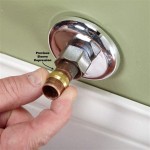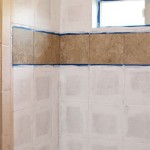How to Fix a Bathroom Sink Plug
A malfunctioning bathroom sink plug can be a significant inconvenience, leading to wasted water, difficulty cleaning, and potential damage to the sink itself. Understanding the common causes of plug malfunctions and how to address them can save time, money, and frustration. This article provides a comprehensive guide to troubleshooting and repairing common bathroom sink plug issues, offering detailed instructions and potential solutions.
Identifying the Problem: Common Sink Plug Issues
Before attempting any repairs, it is crucial to accurately diagnose the problem. Bathroom sink plugs can fail for a variety of reasons, each requiring a specific approach. Some of the most frequent issues include:
The Plug is Stuck in the Open Position: This usually means the plug won’t close properly, allowing water to continuously drain. This can be caused by a disconnected linkage, a corroded or damaged plug mechanism, or an obstruction preventing the plug from seating correctly.
The Plug is Stuck in the Closed Position: Conversely, the plug may be stuck in the closed position, preventing water from draining at all. This is often due to a build-up of hair, soap scum, and other debris around the plug or within the drainpipe. The linkage mechanism could also be seized due to corrosion or misadjustment.
The Plug Doesn't Seal Properly: Even when closed, the plug might not create a watertight seal, resulting in a slow but constant leak. This can be caused by a worn or damaged rubber stopper on the plug, a misaligned stopper, or damage to the sink drain itself.
The Pop-Up Mechanism is Not Working: Many modern bathroom sinks feature a pop-up drain mechanism, controlled by a lever located near the faucet. If the lever feels loose or doesn't engage the plug effectively, the linkage may be disconnected, bent, or broken.
Careful observation is key to identifying the root cause of the problem, making the repair process more efficient and effective.
Gathering the Necessary Tools and Materials
Once the problem has been identified, assembling the necessary tools and materials is the next crucial step. Having everything readily available will streamline the repair process and minimize potential delays. The following is a list of commonly required tools and materials:
Adjustable Wrench: This is essential for loosening and tightening nuts and bolts that secure the linkage and drain components.
Pliers: Pliers are useful for gripping small parts, bending wires, and removing debris.
Screwdrivers (Phillips and Flathead): Different types of screws may be used to secure the linkage or other components, so having both Phillips and flathead screwdrivers is recommended.
Plumber's Putty: Plumber's putty is used to create watertight seals around the drain flange and stopper.
Penetrating Oil (e.g., WD-40): Penetrating oil can help loosen corroded or stuck parts, making disassembly easier.
Drain Snake or Wire Coat Hanger: These tools are used to clear blockages in the drainpipe.
Cleaning Supplies (e.g., Vinegar, Baking Soda, Dish Soap): These can be used to clean the plug, drain, and linkage, removing soap scum and other debris.
Replacement Parts (if necessary): Depending on the identified issue, replacement parts such as a new stopper, linkage, or drain flange may be required. Identifying the correct part number and purchasing it in advance can save time.
Gloves and Safety Glasses: Protecting hands and eyes from dirt, grime, and potential splashes is essential.
Having these tools and materials on hand will ensure a smoother and more efficient repair process.
Step-by-Step Repair Procedures for Common Issues
The following sections outline the repair procedures for some of the most common bathroom sink plug issues. It is important to proceed carefully and methodically, following the instructions closely to avoid further damage.
1. Fixing a Plug Stuck in the Closed Position Due to Debris:
This is often the most common problem and usually the easiest to fix. Begin by attempting to manually remove the plug. If it is firmly stuck, avoid forcing it, as this could damage the stopper or the drain assembly.
First, try running hot water into the sink for a few minutes to help loosen any soap scum. Next, try using a plunger. Ensure there is enough water in the sink to cover the cup of the plunger. Apply firm, consistent pressure to the plunger, repeating the process several times. The pressure may dislodge the blockage.
If the plunger doesn't work, proceed to disassemble the drain assembly. Locate the pivot rod, which is usually a horizontal rod located beneath the sink that connects to the pop-up drain mechanism. Carefully unscrew the nut that secures the pivot rod to the drainpipe. Once the nut is loose, pull the pivot rod out. This will usually release the stopper.
With the stopper removed, thoroughly clean it and the drain opening. Use pliers to remove any hair or debris that may be trapped. A bent wire coat hanger can be useful for reaching deeper into the drainpipe. Flush the drain with hot water to remove any remaining debris. Reassemble the pivot rod and stopper, ensuring the stopper moves freely. Test the drain to ensure it is functioning correctly.
2. Addressing a Disconnected or Damaged Pop-Up Linkage:
If the pop-up lever is not engaging the plug, the linkage beneath the sink is likely disconnected or damaged. Start by visually inspecting the linkage. Look for any loose connections, bent rods, or broken parts. The pop-up mechanism typically includes a vertical lift rod connected to a pivot rod that controls the stopper.
If a connection is loose, tighten the screw or nut that secures it. If a rod is bent, carefully straighten it with pliers. If a part is broken, it will need to be replaced. Replacement pop-up drain assemblies are readily available at most hardware stores.
When reassembling the linkage, ensure that the pivot rod is properly aligned with the stopper. The hole in the pivot rod should align with the hole in the stopper. Adjust the length of the lift rod so that the stopper closes fully when the lever is in the down position and opens fully when the lever is in the up position. Test the mechanism repeatedly to ensure it is functioning smoothly. Lubricating the linkage with a silicone-based lubricant can help prevent future corrosion and ensure smooth operation.
3. Repairing a Leaky Plug Due to a Worn Stopper or Drain Damage:
If the plug closes but still leaks, the stopper may be worn or damaged, or the drain opening may be corroded or uneven. Examine the stopper for any cracks, chips, or deformities. If the stopper is damaged, it should be replaced. Replacement stoppers are available in various sizes and materials. Ensure that the replacement stopper is compatible with the existing drain assembly.
Clean the drain opening thoroughly, removing any soap scum or mineral deposits. Use a scouring pad or wire brush to remove stubborn deposits. If the drain opening is corroded or uneven, it may be necessary to replace the entire drain flange. This is a more involved repair that requires disconnecting the drainpipe beneath the sink.
To replace the drain flange, first shut off the water supply to the faucet. Disconnect the drainpipe from the drain flange using an adjustable wrench. Remove the old drain flange by unscrewing the nut that holds it in place. Clean the sink surface around the drain opening. Apply a bead of plumber's putty to the underside of the new drain flange. Insert the new drain flange into the drain opening and tighten the nut securely. Reconnect the drainpipe and turn on the water supply to test for leaks.
4. Addressing Corrosion and Scale Buildup:
Corrosion and scale buildup are common culprits in sink plug malfunctions, especially in areas with hard water. These deposits can impede the movement of the plug and linkage, leading to sticking, leaking, and eventual failure.
To address corrosion, begin by applying penetrating oil to all moving parts of the drain assembly, including the linkage, pivot rod, and stopper mechanism. Allow the oil to soak in for several hours or overnight. This will help loosen any corroded parts, making disassembly easier.
For scale buildup, a mixture of vinegar and baking soda can be highly effective. Pour one cup of baking soda down the drain, followed by one cup of vinegar. Allow the mixture to fizz for 30 minutes, then flush with hot water. Repeat this process several times if necessary. For stubborn scale deposits, a commercial descaling solution may be required. Follow the manufacturer's instructions carefully when using such solutions.
Regular cleaning of the drain assembly can help prevent future corrosion and scale buildup. Flush the drain with hot water regularly and use a mild detergent to clean the plug and drain opening. Consider installing a water softener to reduce the mineral content of the water, further minimizing scale buildup.
5. Dealing with a Stripped or Damaged Nut:
During disassembly or reassembly, the nuts that secure the linkage or drain flange can become stripped or damaged, making it difficult to tighten or loosen them. Attempting to force a stripped nut can further damage the threads and complicate the repair process.
If a nut is slightly stripped, try using a larger wrench or pliers to grip it more securely. Wrapping a piece of rubber or cloth around the nut can also provide additional grip. If the nut is badly stripped, it may be necessary to use a nut splitter. A nut splitter is a tool that cuts the nut in half, allowing it to be removed without damaging the threads on the bolt or pipe.
When replacing a damaged nut, ensure that the replacement nut is the correct size and thread pattern. Use a brass or stainless steel nut to prevent future corrosion. When tightening the nut, avoid over-tightening it, as this can strip the threads or damage the components. A moderate amount of torque is usually sufficient.
Applying a thread sealant to the threads of the bolt or pipe before tightening the nut can help prevent leaks and ensure a secure connection. Teflon tape is a commonly used thread sealant for plumbing applications.
Addressing these common sink plug issues with the correct tools and techniques can restore proper drain function and prevent further problems. If the issue is beyond the scope of these instructions, consulting a qualified plumber is recommended. Failure to properly address plumbing issues can lead to more extensive damage and costly repairs.

5 Natural Ways To Unclog A Bathroom Sink Hiller How

How To Fix Or Maintain Your Sink S Pop Up Mechanism

How To Replace A Sink Stopper Quick And Simple Home Repair

How To Fix Pop Up Drain Waste Plug
Install A Drain Stopper So The Is Removable
How To Get A Bathroom Sink Plug Removed When It Won T Un Quora

Bathroom Sink Popup And Stopper Problems

Step By Guide On How To Install Sink Pop Up Drain Stopper
I Closed My Sink Drain Stopper And Now It Won T Open Again Is There Any Way That Can Repair This Without Hiring A Plumber Quora

Quick Tip 26 Pop Up Stopper Sticks Misterfix It Com
Related Posts







